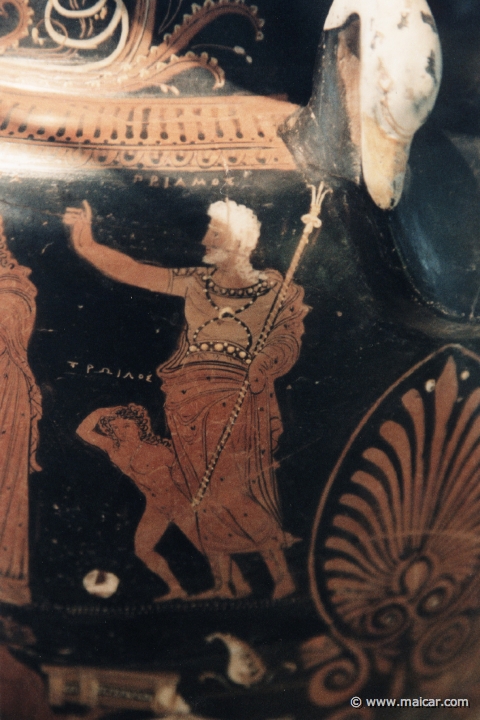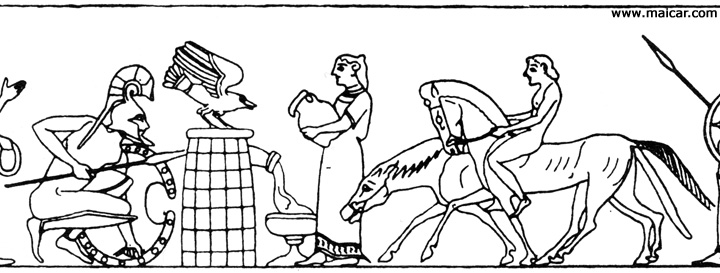|

|
Priam 1 and his son Troilus. 5724: Priam et Troïlos. Apulie "Peintre de Schultess", vers 340 avant J.-C. Musée d'Art et d'Histoire, Genève.
|
|
|
"Woe is me, that am all
unblest, seeing that I begat sons the best in the
broad land of Troy, yet of them I avow that not one
is left, not godlike Mestor, not Troilus the
warrior charioteer, not
Hector that was a god among men..."
(Priam 1 to his
remaining sons. Hom.Il.24.255).
|
|
Troilus was the youngest son of Hecabe 1, either by Priam 1 or by Apollo (Apd.3.12.5;
QS.4.420; Hyg.Fab.90).
In the first years of the Trojan War, Troilus
was killed by Achilles,
who had already driven off the cattle of Aeneas, and sacked the
cities of Lyrnessus (where Achilles captured Briseis) and Pedasus,
among others (Proclus, Chrestomathy, i). It
is at this time that Achilles captured Lycaon 1 (son of Priam 1 and Laothoe 2, daughter of Altes, king of the Lelegians of Pedasus on the river Satnioeis—Hom.Il.21.85), selling him
into slavery in Lemnos (the island in the northern Aegean Sea). Lycaon 1 recalls the episode when Achilles captured him a
second time in the tenth year of the war, only
twelve days after his return from Lemnos. Lycaon 1 then asks once more for mercy:
"I beseech
thee by thy knees, Achilles, and do thou respect me and have
pity; in thine eyes, O thou nurtured of Zeus, am I even as a sacred suppliant,
for at thy table first did I eat of the grain of Demeter on the day when thou didst take me
captive in the well-ordered orchard, and didst lead
me afar from father and from friends, and sell me
into sacred Lemnos; and I fetched thee the price of
an hundred oxen ... slay me not; since I am not
sprung from the same womb as Hector, who slew thy comrade the kindly
and valiant." (Hom.Il.21.74).
...but this time Achilles kills him,
throwing his body into the river Scamander.
Apollodorus (Epitome 3.32) says that Achilles killed Troilus
in the sanctuary of Thymbraean Apollo, before making his
way to Mount Ida to attack Aeneas (who, however, had already fled), before capturing Lycaon 1 for the first time, and before killing Mestor 2—another son of Priam 1—(Apd.3.12.5; Hyg.Fab.90).
A picture which Aeneas sees in Carthage, where he came as an exile after
the war, depicted the scene of Troilus' death:
"... Troilus,
his arms flung away in flight—unhappy boy, and
ill-matched in conflict with Achilles—is carried along by his
horses and, fallen backward, clings to the empty
car, yet clasping the reins; his neck and hair are
dragged over the ground, and the dust is scored by
his reversed spear." (Virgil, Aeneid 1.471)
But according to Dictys 4.9, Lycaon 1 and Troilus were captured at the same time in the tenth year of the war, after the deaths of Sarpedon 1, Hector 1, and Memnon. The Trojans had
been challenged to come out and fight, and so they
did—led by Paris and his brothers—but they soon took to flight. Thus were Lycaon 1 and Troilus captured by the Achaeans, who cut their throats in cold blood by order of Achilles. The
Trojans grieved Troilus' death, says Dictys,
"...for they
remembered how young he was, who being in the early
years of his manhood, was the people's favorite,
their darling, not only because of his modesty and
honesty, but more especially because of his
handsome appearance."
A few days later, Achilles himself was
killed, victim of a plot conceived by Paris and Deiphobus 1 around the matter of Achilles' love for
their sister Polyxena 1 (Dictys 4.11).
A number of vases, however, show Troilus (with
his horses) and Polyxena 1 as they approach a well to fetch water, being
observed or ambushed by Achilles.
Frazer (footnote to Apd.Ep.3.32.a)
writes: "Tzetzes says ...
that he (Troilus) fled
from his assailant to the temple of Apollo, and was cut down by Achilles at the altar. There was a prophecy
that Troy could not be taken if Troilus
should live to the age of twenty (so the First
Vatican Mythographer). This may have been the
motive of Achilles for slaying the lad."
Troilus' death in the temple of Apollo is evoked by
Statius, Silvae 2.4.33:
"... or Troilus, when the lance from the Haemonian hero's arm (Achilles) caught him as he fled round cruel Phoebus' walls."
The love of Achilles for Troilus is deduced from the cryptic Lycophron
(Alexandra 307) and his scholiast:
"Ay! me, for
thy fair-fostered flower (Troilus), too, I groan, O lion whelp, sweet
darling of thy kindred, who didst smite with fiery
charm of shafts the fierce dragon (Achilles) and seize for a little loveless
while in unescapable noose him that was smitten,
thyself unwounded by thy victim: thou shall forfeit
thy head and stain thy father's (Apollo) altar-tomb with thy blood."
Achilles raped
Troilus and then beheaded him at the temple of Apollo. Or he lured him with a gift (doves) and then killed him (Serv.Aen.1.474, through Roscher, Lex. 5.1217).
According to Dares (7), Troilus ("though youngest of Priam's
sons") supported Paris' idea of sending a
fleet to Hellas to obtain reparations for the
abduction of Hesione 2,
against the warnings of Helenus 1. He describes
him thus:
"Troilus, a
large and handsome boy, was strong for his age,
brave, and eager for glory." (Dares 12)
|

|
Achilles observes Polyxena 1 and Troilus as they approach the well. RIII.2-2727: Achilleus, Polyxena am Brunnen und Troilos. Hydria aus Vulci (nach Annali dell Inst. Arch. 1850 Taf. E1). Wilhelm Heinrich Roscher (Göttingen, 1845- Dresden, 1923), Ausfürliches Lexikon der griechisches und römisches Mythologie, 1884.
|
|
And he also counts him as a general, as when he
says: "Agamemnon, Achilles, Diomedes, and Menelaus led forth the army. The forces of Hector, Troilus and Aeneas moved opposite" (Dares 20),
or "After three years, the
war was resumed. Hector and Troilus led forth the
army" (23), or "Priam, therefore, divided the command of
his forces between Alexander (Paris), Helenus, Troilus, and Aeneas" at a time when Andromache sent word
to Priam 1 to keep Hector 1 out of the
battle (24).
Later (29), we learn that Troilus' forces
confronted Agamemnon's
in a battle that lasted seven days, in which "Troilus slaughtered many Greek
leaders." After a two-months truce, "Troilus, having wounded Menelaus, pressed on, killing many of the
enemy and harrying others" in a fierce
battle that only night brought to an end. Then new
day and new battle, in which Troilus wounded both Diomedes 2 and Agamemnon. The
Achaeans then ask for a six-months truce, and
against Troilus opinion, the Trojan council granted
the petition (31).
When the truce was over, Agamemnon (this time
supported by Achilles'
Myrmidons) confronted Troilus, who, however, put to
flight the Myrmidons. He then pressed his attack
into the Achaean camp, killing and wounding many,
until he was stopped by Ajax 1. The next day Troilus puts to flight Agamemnon and the Myrmidons once more, after which a thirty-day truce for holding funerals was agreed (32).
When war started again, Troilus defeated Agamemnon and the
Myrmidons once more. This time, Achilles (who had kept
himself away from battle), seeing the Trojan
advance, reentered the battle, but was wounded by
Troilus. Achilles stayed out of action for six days because of his
wound. Towards the end of the seventh day, Troilus
advanced on horseback, causing the enemy to flee.
But then Achilles and
the Myrmidons came to their rescue, wounding
Troilus' horse, and as Troilus was thrown off and
entangled, Achilles killed him (33). Achilles then tried to
drag off the body, but was wounded by Memnon and forced to
yield. The death of Achilles was planned by Hecabe 1 to avenge the
deaths of Hector 1 and
Troilus: Achilles was
summoned to come to the temple of Thymbraean Apollo "to settle an agreement according
to which she would give him Polyxena to
marry". An ambush was set up, and Paris killed Achilles (34). |